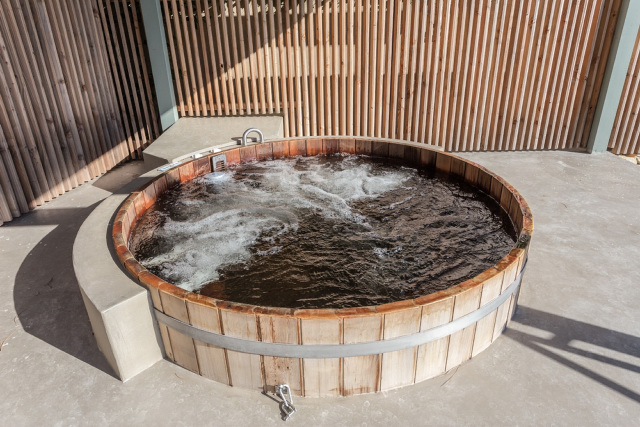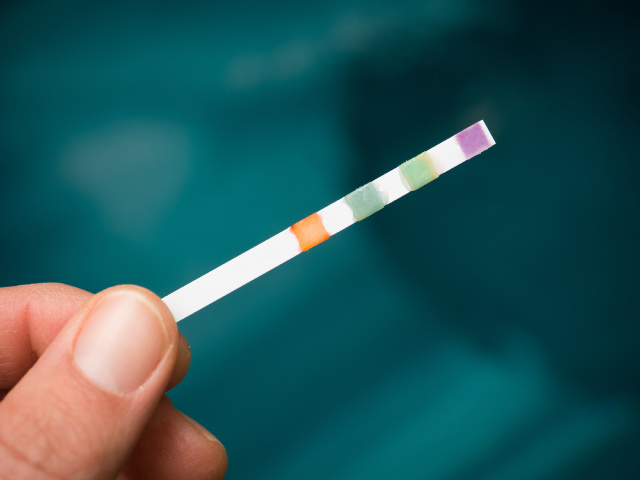Perhaps you’ve recently noticed the cyanuric acid (also known as a stabilizer) in your hot tub a bit higher than normal and would like to know how to lower it back down. In this article, I’ll be showing you just how you can do that, plus why it might’ve been high in the first place so that you can prevent it from happening again.
To lower or reduce the cyanuric acid (also known as CYA or stabilizer) level in a hot tub, drain 1/4 to 1/2 of the water from the hot tub, then top it back up with fresh water. This is known as dilution. This is the only way to reduce the stabilizer as it does not dissipate in the water or naturally reduce.
Whilst the above method will reduce the stabilizer levels, there’s more to it than that. Before we move on to tackling the issue in detail, let’s first take a closer look at what a high stabilizer means and how to test for it.
After all, you’ll want to make sure your stabilizer levels are indeed high before you spend your time fixing it.

Article Contents
What is Stabilizer (Cyanuric Acid or CYA)?
Stabilizers are chemicals that prevent your hot tub sanitizer, chlorine, from breaking down too quickly. They are used both for chlorinated outdoor hot tubs and also in swimming pools.
Typically, chlorine by itself will lose complete effectiveness under UV light in only a few hours. As such, stabilizers can keep the chlorine in your hot tub active for a much longer period, hence lessening your need to spend extra effort and money to add additional chlorine throughout the day.
Check out this article if you want to go into detail on how exactly chlorine breaks down under UV light in your hot tub: Do Hot Tubs Need Stabilizer
Because chlorine breaks down quickly under UV light, stabilizers are only used for outdoor hot tubs.
Effects of High Stabilizer – Is it Dangerous?
Having high levels of stabilizer can be dangerous and will reduce the effectiveness of chlorine. The more stabilizer that is in the water, the less effective the chlorine becomes. Put another way, you’ll need to maintain higher chlorine levels to counteract the effects of a high stabilizer.
The fact that chlorine has become ineffective means that it won’t be doing its job of sanitizing your hot tub water.
Thus, there will be a high risk of:
- Bacteria
- Viruses
- Algae
Related Reading: What is Swimming Pool Stabilizer & When To Add It
How to Test for High Hot Tub Stabilizer
The two ways of measuring your hot tub stabilizer level. To confirm if it’s high you can use either a drop test/testing kit or test strips.

Testing Stabilizer Levels Using a Drop Test
A drop test (aka DPD Test Kit) involves the use of a liquid testing kit. These kits typically require you to drop a reagent into a water sample you’ve collected from your hot tub. After mixing the solutions, you’ll be able to see a color change which you can then compare with a guide that comes with your kit to see where your stabilizer level lies.
Pros of Using Testing Kits
Assuming you’ve used the right amount of reagent, testing kits yield more accurate results than test strips. Different reagents measure different chemicals in the water so a testing kit can be quite versatile.
Cons of Using Testing Kits
On the other hand, liquid drop testing kits can easily give out false information if the wrong proportions are added. And of course, due to the somewhat more complex methodology and its more accurate readings, testing kits are usually more expensive than testing strips.
But all that said, every hot tub owner should invest in a high-quality test kit. In the long run, you’ll save money by adding the correct amount of chemicals (not over or under).
Here’s a quality test kit.
Testing Stabilizer Levels Using Testing Strips
Testing strips are an easy and quick way to test for stabilizer level. Make sure you get a test strip designed for cyanuric acid. Simply submerge the test strip into the hot tub for a set amount of time, then remove it to allow the water to react with the reagent on the test strip.
You then compare the color with a range of colors on the test strip package to estimate where your stabilizer level lies.
Pros of Using Test Strips
Test strips, because of their simpler design, are cheaper than a liquid (drop) testing kit. They’re also easier to use and yield faster results.
Cons of Using Testing Strips
If you have the time and money (the cost isn’t sky high), you’d better go with the liquid testing kit because testing strips are notorious for giving out inconsistent results when it comes to testing for cyanuric acid and other chemicals.
This is because the colors on the strip will change over time due to certain environmental conditions.
False readings mean you may add too much or too little of a chemical leaving your spa out of balance. Which is bad for swimmers and for your tub.
Related Reading: Swimming Pool Test Strips Vs Drops or Liquid Test Kits
Where Should Hot Tub Stabilizer Level Be At?
It’s crucial for you to test your stabilizer level to make sure it’s within the appropriate range. Anything outside of the range can prove detrimental.
What is Considered Low Stabilizer Level?
The stabilizer level is considered low if it’s below 30 ppm (parts per million). Having a level below 30 ppm can make your chlorine more susceptible to UV light, however, it’s still better than not having a stabilizer at all.
What is Considered a High Stabilizer Level?
The stabilizer level is considered high if it’s above 50 ppm (parts per million). Having too much stabilizer can result in the same problem you’re trying to avoid. We’ll go over this in more detail later.
What Causes Hot Tub Stabilizer to be High?
The most common reasons why the stabilizer level in your hot tub is high are because you’ve either added too much cyanuric acid (directly to the water) or you’re using chlorine products that contain stabilizers.
You’re Using Chlorine Products That Contain Stabilizer
The most common reason you have high stabilizer levels is that you’ve been using chlorine which already contains stabilizer.
Stabilized chlorine products, such as dichlor and trichlor, although good at staying effective under the sun, contain stabilizers. As you use more stabilized chlorine, the stabilizer will remain in the water (as it doesn’t degrade) and continue to accumulate until you notice and fix the situation.
To avoid this, you can,
- Switch to non-stabilized chlorine (like liquid chlorine or bleach/Clorox)
- Drain and refill your spa
You’ve Added Too Much Cyanuric Acid
The other way to add cyanuric acid is to add it as a separate chemical. The simple explanation as to why you have high stabilizer levels is that you’ve miscalculated how much cyanuric acid you needed for your hot tub size and accidentally added too much.
How to Lower Stabilizer Level in Hot Tub
The two ways of lowering your stabilizer level are to either drain your hot tub and refill it with fresh water or consider using a cyanuric acid reducer.
Draining your Hot Tub and Adding in Fresh Water
This is by far the most common way of lowering the stabilizer level in a hot tub. Here are the steps to follow:
1. Test the Water
Before actually diluting the water, use the test strips or testing kit to make sure your cyanuric level needs lowering.
2. Calculate the Amount of Water to Drain
Determine how much water you’d need to replace by subtracting the optimal stabilizer level from your current stabilizer level, then divide that answer using your current stabilizer level;
For example, if you currently have an 80 ppm stabilizer level but you want to bring it down to 50 ppm. First subtract 50 ppm from 80 ppm, which gets you 30 ppm. Now divide by 80 ppm. This gives you 37.5%. Meaning you’ll need to replace approximately that much from your current hot tub water
3. Drain the Water
You can drain the water several ways: either by using a hose siphon, submersible pump, or manually using things like buckets
4. Fill Your Hot Tub with Fresh Water & Retest
Refill your hot tub with fresh water and retest the water chemistry (including the pH, sanitizer, and alkalinity levels.
If the stabilizer level is too high, drain some more water and top up with fresh water.
Remember to wash or change your filter as there may be some residue left over;
Using a Cyanuric Acid Reducer
Though an option if the stabilizer level in your hot tub is too high, cyanuric acid reducers are typically not used as often as the draining method because they tend to be quite expensive and will not work for every hot tub. Test your water chemistry to make sure the other parameters (i.e. pH and alkalinity) are in range before using.
Related Reading: Can You Over Shock Your Hot Tub or Spa?
How to Bring Stabilizer Back Up
In case you’ve lowered the cyanuric acid too much, you can either add stabilized chlorine or pure cyanuric acid to the hot tub water.
If you usually use stabilized chlorine, just continue adding it as needed. The stabilizer levels will rise slowly to where you need them to be.
If you find it too slow, you can add a stabilizer (cyanuric acid) separately. This method will grant you more control over the stabilizer level. Just be careful to calculate the amount carefully. You don’t want to overshoot.
Final Thoughts
Having a high stabilizer level in your hot tub can seem daunting at first, however, there are several simple and quick ways of fixing the issue. As long as you have the time, you’ll just have to dilute your hot tub water and you’ll see the stabilizer level drop down to normal in minutes.
As long as you avoid adding in too much-stabilized chlorine or cyanuric acid, you can be sure to never come across this issue again.
Related Reading:
Complete Guide to Using Stabilizer in Saltwater Pools
Should You Use Stabilizer for Indoor Pools?
How to Dissolve Pool Stabilizer | Stabilizer Not Dissolving
Should You Insulate a Hot Tub Pad? (How and What to Use)
Can You Use Clorox or Bleach in a Hot Tub?



